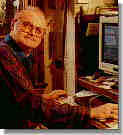
Paris, Page Three
Church of the
Invalides
(St-Louis-des-Invalides)
Military Museum at Invalides
Tuesday, June 27, 2006
Sections
Alt.Mail
Special Reports
Paris, Thursday, April 19, 2001.
From inside the Dome that houses Napoleon's Tomb you can see there is another church attached, but there is no passage from one to the other. Going outside and around we found the Church of the Invalides, which is a working parish church; one presumes that many of its members will be the retired veterans and patients in the hospital that is part of the complex, as well as the cadets in the military academy. The church is decorated with captured battle flags dating back hundreds of years
 |
 |
 |
Looking forward toward the high altar you see through to the Dome church behind. This is clearly a veterans' church: note the flags. Looking back from the altar rail is the organ, which is quite old, and was used as the instrument for the premier performance of Berlioz's Requiem (with the assistance of artillery from the Ecole Militaire; the artillery was outside...)
 |
 |
 |
There is also a museum of fortress models. These were working models used by the French military, and the room was considered top secret until relatively recent times. You can see why: in the days before satellite pictures, these models would be invaluable, particularly in the siege warfare era. They have been made and updated since the time of Louis XIV. On the left is Toulon harbor. It's really impossible to show the detail of a fortress chain like Strassbourg, so I include a couple of simpler models: the Chateau d' If of Count of Monte Cristo fame, and Mont Saint Michele...
 |
 |
The museum is more than ancient armor and cannon, of course. This tank guards the stairway to the hall of honor. A plaque commemorates the French who fell in Korea. As it happens I knew some of those troops, and have some reason to be grateful to them. As for the next plaque, anyone who has read my Falkenberg books will understand why it is included. A moi! La Legion!
 |
The changing face of war. Bearskins and the forerunner of the machinegun. Cannon in the courtyard. And the Old Guard dies but it does not surrender. Vive l' Empereur!
 |
 |
 |
 |
 |
 |
Looking North from the gate of the Invalides toward the Seine, you see, not the Pont des Invalides as you might expect (that is a bit to the west) but the Pont Alexandre III, a considerably more ornate deal built 1897-1900.
There are parks or squares between Invalides and the river. They have this sign at intervals. I presume it means 'keep off the grass' but it seems an odd way to phrase it. You see knots of impolite teenagers blocking the sidewalks at bus stops, and to get past them you have no choice but to step on the grass. So it goes. We weren't arrested. (I have since been told that the sign says it is forbidden to play ball here. )
You can see the Eiffel Tower all along here. There is also a double deck tour bus, but few were hardy enough to brave the winds. French taxes aren't particularly higher than ours, but they maintain many parts of the Capital with broad parks and no trash. I wish we could afford to do that, but apparently we have other things to do with the money that goes to the District of Columbia. Pity. The Alexander III bridge leads across to museums on the right bank but I didn't go across this trip.
A quai is a waterside street, and the Quai D' Orsay is just up there. My memory must be playing tricks on me, because I remember that the foreign ministry is called the Quai d' Orsay, but there is no sign of anything like that there, on the ground or in the guide books. There is a police station, which I think I recall is the HQ for Inspector Maigret, but I may be wrong about that, too. The most prominent building along the Quai D' Orsay was painted with a huge Air France sign...
The Invalides area makes for an interesting walk. There's a Rodin museum there also; it's the objective for another day. Mostly I was impressed with the way things work here. Perhaps they don't always, but this was spring, not very good weather, but the streets are clean, the roads may be a bit rough but there are no horrible pot holes, the sidewalks are quite rough but they're passable, and despite rude teenagers (findable anywhere in the world now), it's quite orderly. The metros work, the stations are clean, and the city is clean and a pleasant place to walk barring that we got hail later that day...
End of Page Three of Part One, A Paris Trip Report
Back to Page Two Back to Page One
